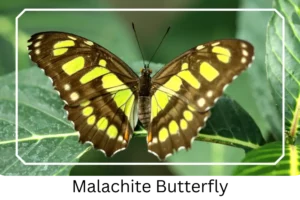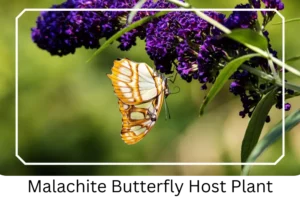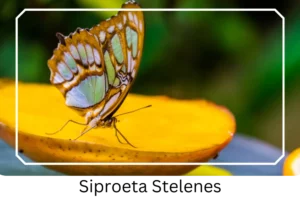Malachite (Siproeta stelenes)
The Malachite Butterfly, a striking species native to the lush tropics of South America, captivates enthusiasts and researchers alike. Belonging to the brush-footed butterfly group, this butterfly is not only recognized for its impressive size but also for its distinctive coloration. It thrives across Central and Northern South America, with some sightings as far north as Florida, USA. The Malachite Butterfly’s presence is a testament to the rich biodiversity of its habitats, ranging from mango orchards to semideciduous forests.
Scientific Classification
- Family: Nymphalidae
- Genus: Siproeta
- Scientific Name: Siproeta stelenes
Overview
Known for their vivid hues and large wingspan, Malachite Butterflies are among the largest butterfly species globally. Their lifecycle, from the visually unique caterpillar stage to the enchanting adult form, showcases nature’s marvel. The Malachite Butterfly’s diet is as diverse as its habitats, indulging in everything from flower nectar to bat dung. This butterfly’s name, inspired by the mineral malachite’s similar green shade, reflects the natural world’s interconnectedness.
Description and Identification
Caterpillar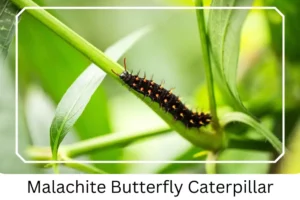
The caterpillar stage of the Malachite Butterfly is as fascinating as its adult form. These larvae boast a striking black color with red spotted markings along their back, arranged in two straight lines. Horned feelers and spiny projections emanating from each red spot make them a formidable sight. They primarily feed on the leaves of their host plants, a crucial step in their development.
Pupa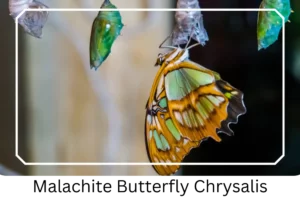
Transitioning to the chrysalis, the Malachite Butterfly’s pupa is a vibrant green, dotted with small protrusions that blend seamlessly with the foliage of their host plants. This camouflage is a natural defense mechanism against predators.
Adult Butterfly
Sexual Dimorphism:
While both sexes exhibit minimal differences, males and females can be distinguished by the slightly fainter coloration and patterns on the females’ wings.
Color and Appearance:
With large wings that showcase a mesmerizing combination of black and brilliant green or yellowish green on the upper side, the Malachite Butterfly is a sight to behold. The underside reveals a more subdued palette of light brown and olive green.
Average Wingspan: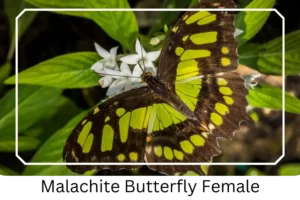
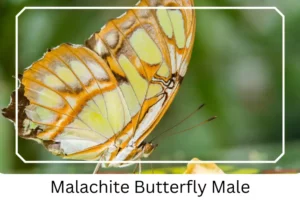
The wingspan of an adult Malachite ranges between 8.5 and 10 cm (3.3 and 3.9 inches), placing them among the world’s largest butterflies.
Flight Pattern:
Their flight is slow and floating, allowing observers to admire their beauty fully.
Eggs
The eggs of the Malachite Butterfly are green, laid singly on the new leaves of the host plant, signaling the start of a new lifecycle.
Quick Facts | |
| Distribution | Central and northern South America; occasional sightings in Florida, USA. |
| Habitat | Prefers orchards and semideciduous or subtropical evergreen forests. |
| Host Plants | Favors Acanthaceae family plants, including cafetin and ruellia. |
| Adult Diet | Varied, including flower nectar, rotting fruits, animal carcasses, and bat dung. |
How to Identify Malachite Butterfly?
Identifying a Malachite Butterfly involves looking for its unique coloration and wing patterns. The vivid green and black markings on the upper side of their wings are distinctive, mirroring the appearance of the malachite mineral. When the wings are closed, the underside’s lighter colors help differentiate them from similar species. Observing their flight pattern can also aid in identification; their slow, floating flight is characteristic of the Malachite. Additionally, their large wingspan and the habitats they frequent – ranging from orchards to subtropical forests – can provide clues to their identity. Whether you’re a seasoned entomologist or a casual nature enthusiast, recognizing a Malachite Butterfly offers a glimpse into the rich tapestry of biodiversity.
Did You Know?
- Malachite Butterflies are often mistaken for the dido longwing, but their wing shapes are a key differentiating feature.
- Despite their size, these butterflies are voracious eaters, capable of feeding throughout the day.
- They can reach flowers up to 38 feet high in the canopy, showcasing their impressive flying capabilities.
- The butterfly’s name is derived from the malachite mineral, which shares its vibrant green coloration, illustrating nature’s palette.
Conclusion
The Malachite Butterfly stands as a symbol of the vibrant and diverse ecosystems of South America. Its lifecycle, from caterpillar to majestic adult, is a remarkable journey that highlights the complexity and beauty of nature. By understanding and appreciating these creatures, we not only gain insight into their world but also the importance of conserving the environments that sustain them. The Malachite Butterfly, with its unique characteristics and role in the ecosystem, continues to fascinate and inspire those fortunate enough to witness its beauty.

